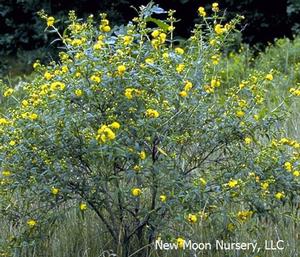Printed at http://www.newmoonnursery.com/index.cfm/
Hypericum prolificum
shrubby St John's wort
Native to North America
FIRST IMPRESSIONS: Hypericum prolificum is a densely branched native shrub with an attractive shaggy rounded form. Older woody stems have attractive mahogany colored peeling bark. In summer the narrow foliage is adorned by clusters of small bright yellow flowers. This shrubby perennial thrives in sunny moist, mesic or dry sites.
HABITAT & HARDINESS: Hypericum prolificum occurs in Ontario and from Maine to Florida and west to Minnesota and east Texas.
Habitats include upland prairies, meadows, rocky bluffs, open upland woods, rocky stream banks, swamp margins, old fields, pastures and roadsides.
Plants are hardy from USDA Zones 3-8.
PLANT DESCRIPTION: Hypericum prolificum is a densely branched and rounded deciduous shrub with a branching woody root system.
Young stems are green becoming woody with age. At maturity they develop shedding brown and orange bark.
Leaves are opposite, bright green and linear or narrowly oblong. Blades are 3” long and about ¾’ wide with smooth edges. They are either sessile or have very short petioles.
In summer for about 2 months, the stems are tipped by small clusters of 3-7 flowers. The individual flowers are about 1” across. They have 5 yellow petals surrounding a dense cluster of pollen laden stamens.
Small oval capsules appear after flowering. At maturity, the capsules turn lustrous brown and split into 3 parts releasing tiny black flattened seed.
Plants grow 1-5’ with 1-4’ spread.
CULTURAL & MAINTENANCE NEEDS: Hypericum prolificum is easy to grow in sunny or partly shaded sites with average well drained soil.
This adaptable shrub tolerates drought, brief flooding, moderate salinity and barren rocky, sandy or clay soils. Plants are fairly pest free and are unpalatable to deer and other herbivores.
If trimming is needed, pruning should be scheduled in early spring.
LANDSCAPE USES: This shrubby wildflower is a good Hedge, Grouping or Mass for a Wildlife Garden. Plants offer Winter Interest and Showy Blooms that are always buzzing with Pollinators. Hypericum prolificum injects interest into Perennial Borders and is useful for Erosion Control or as a Butterfly Host Plant. Plants are welcome additions to Cottage Gardens, Low Maintenance Plantings, Rain Gardens and Roadsides.
COMPANION & UNDERSTUDY PLANTS: Try pairing Hypericum prolificum with Aster oblongifolius, Hibiscus moscheutos, Monarda fistulosa, Panicum virgatum, Rudbeckia hirta or Silphium perfoliatum.
Ceanothus americanus is another shrubby summer blooming wildflower that could be substituted in some situations.
TRIVIA: The flowers of Hypericum prolificum lack nectar and so are pollinated by pollen seeking bumblebees. Syrphid flies and Halictid bees forage for pollen from the flowers. Plants host caterpillars of Gray Hairstreak butterflies and several moths.
Foliage contains the phototoxic chemical hypericin which can irritate the digestive tract or cause rashes on animals exposed to sun. For this reason, deer and other herbivores generally do not browse the foliage.
In Europe, Hypericum spp was associated with John the Baptist because it was in bloom on his nativity feast on June 24th. The generic name Hypericum is derived from the Greek words “hyper” meaning over and “eikon” meaning image or apparition. It was believed that Hypericum spp had power over demons or ghosts. Sprigs were gathered on the eve of St. John’s Day and used to keep evil spirits at bay. The common name St. John’s wort was adopted because of this practice.
Height:
1-5 ftSpread:
1-4 ftSpacing:
2 ftUSDA Hardiness Zone:
3-8Bloom Color:
Gold, GreenHypericum prolificum Characteristics
Attracts Wildlife
- Butterflies
- Pollinators
Attributes
- East-Coast Native
- Drought Tolerant
- Cut Flower
- Coastal
- Clay Soil
- Rock Garden
- Naturalizing
Exposure
- Full Sun to Partial Shade
Deer Resistant
- Deer Resistant
Flowering Months
- August
- July
- June
Foliage Color
- Green
Growth Rate
- Medium
Juglans nigra Tolerance (Black Walnut)
- Yes
Salt Tolerance
- Medium
Season of Interest (Foliage)
- Summer
- Spring
Soil Moisture Preference
- Dry to Moist

